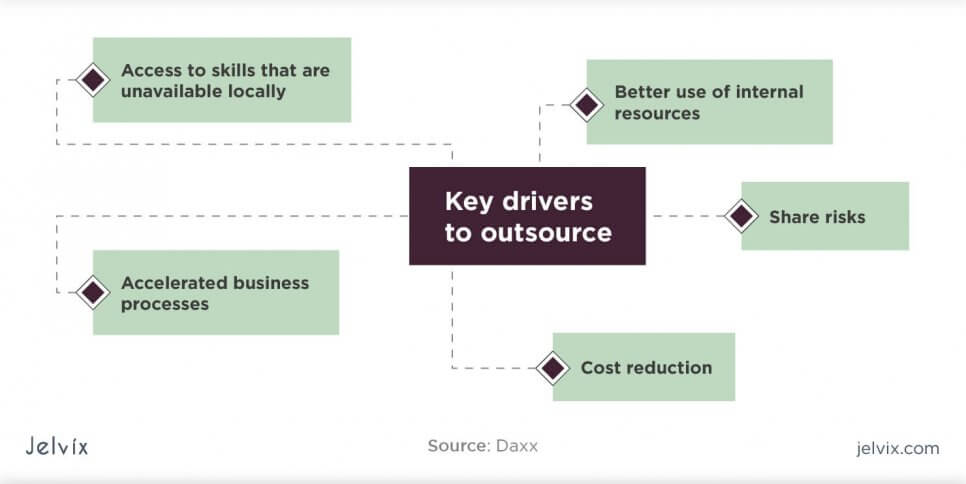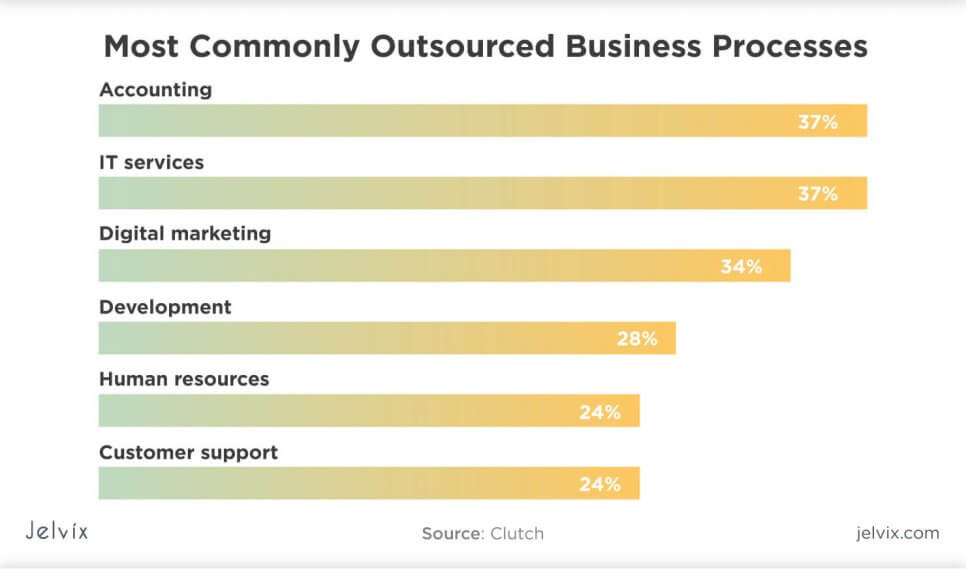Outsourcing has been at the peak of its popularity for the last decade. From large enterprises to SMEs and startups, more and more are following a global trend to outsource their software development projects to teams overseas. However, before getting started with outsourcing, you should be aware of the possible risks that might occur in this model.
We asked our developers and clients to share the main challenges associated with outsourcing. We also shared our experience of solving these issues, giving you actionable insights on the topic.
Outsourcing: Quick Model Overview
Outsourcing as a business strategy appeared in the 1970s in the manufacturing industry. The firms started outsourcing their accounting, payroll, and back-office operations that lead to 80% of internal services being outsourced to other countries. These days, outsourcing is widely used in lots of industries, including healthcare, retail, real estate, car manufacturing, and, in particular, IT software development.
Companies all around the world spent $75.2 billion in 2019 for outsourcing, with over 78% of the clients claiming that outsourcing is probably the most beneficial business strategy for growing the business. Moreover, companies believe that outsourcing has saved many companies from a crisis during the Global Recession in 2008.
Offshoring outsourcing is common in the United States – almost 300,000 jobs were outsourced to Europe in 2018-2019. Going offshore is quite challenging as the distance between the client and the team is considerable. However, outsourcing software development in CEE is believed to be worth the risk, taking into account a significant difference in salary rate between the US and Ukraine.
Based on the survey, global information technology outsourcing hit $66.5 billion in revenue in 2019. And undoubtedly the number will continue to grow. Outsourcing comes with smart labor costs, a large talent pool, new market opportunities, and cutting-edge technologies. However, despite all the advantages, there still are some problems with outsourcing. So let’s take a closer look at the ways to smooth them out.
The Most Common Types of Outsourcing
Delegating a part of a whole project can be realized via several models, each of which has its benefits and limitations. Without further ado, let’s see what these are.
Freelance Platforms
The easiest and most popular way to find a cheap workforce is to hire freelance developers. With a tremendous number of reliable platforms, you can find the one with the needed qualification to complete your project for a very attractive price. However, be aware that freelance workers are not reliable, meaning that they can escape the project beforehand as no official contract is signed. Moreover, a freelancer usually works on several projects simultaneously, so do not expect much quality or meeting deadlines.
Fixed-Price Contracts
This model will probably work for you if you have defined and clear goals, requirements, and intentions. You know the exact date when your project should end, you know what technologies you will be using, what team you need, and other crucial details. No notorious presale discussion – you provide this information and get a fixed-price contract to sign.
Time and Materials
The project is delivered on a standard basis and the payments are conducted according to the hours actually spent. The model is more flexible than the fixed-price one. Particularly good for open-ended, long term projects where it is hard to make a solid estimation of required efforts, or there is a need to constantly add new features.
Nearshoring/Offshoring
This is the most reliable and trusty model, used by large tech giants, SMEs, and startup businesses. The principle of cooperation is simple – choose a country, select a vendor, build a team, and get started. The difference between nearshoring and offshoring is simple – either short or long distance. Moreover, nearshoring vendors usually give you full control of your team. This means that you are the only person who can interact with all stages of the project’s execution and be involved in them. Nonetheless, be aware that if you lack a tech background, you won’t be able to gain success with a dedicated development team. Usually, companies that do not have solid technology expertise hire a CTO or CTO-as-a-Service, who performs the project’s tech management.
Most Common Reasons for Outsourcing
Outsourcing means delegating an entire project or a part of it to the dedicated development team in another country. Designing a brand new product, creating a competitive position on the market, establishing a reputation, getting the best human resources, and other crucial aspects drive the companies towards choosing the outsourcing model as their strategic business approach. Let’s go through the most popular reasons why they decide to outsource software development services.
- Reduced and manageable operational costs
Outsourcing allows you to choose when to start a project, depending on your financial capabilities. By properly analyzing the market and your business needs, you will find affordable prices for your services to be done in a quality and timely manner.
- Smart costs on labor
Some comparison here: an average US company spends around $85,539 to hire a software developer; to fulfill the same position, a German company will spend $55,789 (€49,417); and Ukraine will offer you a software developer with around $24,109 paycheck. With this in mind, Ukraine remains an attractive destination for outsourcing for the cost-effective reasons that are beneficial for both tech giants, startups, and SMEs.
- Cutting-edge technology
With an ever-increasing scope of technology tools and services, you can find any specialist around the world being proficient in even quite rare technologies. Professional IT developers will boost your business by implementing the latest technologies and designing a competitive product in the best possible way. Ukraine is claimed to be one of the leading countries in CEE to provide a wide variety of software solutions, development, and design with an innovative eye. For instance, at Jelvix, dedicated teams of developers use the latest technology stacks, frameworks, and other tools to grow clients’ businesses. They cover a great variety of services: from IT Consulting to Mobile and Web Development.
- Low level of turnover
Managing the in-house team means always keeping an eye on their professional and personal needs. You have to create a distinctive corporate culture, consider hiring HR employees to make sure your employees’ behaviors are analyzed, and all the issues are detected. With remote teams, retention is not your pain as the vendor is responsible for your developers’ overall satisfaction. Your part in this process is simple – talk to them and listen to what they think, be collaborative, and always find wise ways to solve any arising issues.
- Access to new marketplaces
If you decide to outsource an entire project – to design a product from start to finish – outsourcing allows you to find your niche on the local market. You will be able to enrich your target audience, gain recognition from the domestic users, and discover new partnerships to advance your business operations even more. Outsourcing to CEE countries gives you a tremendous jump to establish a competitive position in the whole European IT market with high-end quality and proactive approach.
Advantages and Disadvantages of Outsourcing
Before you head to the supermarket, you prepare – you thoroughly scan the products in your fridge, define what you need to buy, and make a list. With outsourcing, the scheme is similar: before you refer to an outsourcing company, you analyze the pros and cons of outsourcing and make a list of concerns. So let’s delve into the details of the outsourcing model.
Risks of Outsourcing
Despite all the benefits that outsourcing brings, knowing the risks is a crucial strategy to mitigate pitfalls and take the best of the model’s use. In the following section, we will not only define the harmful effects of outsourcing but also discuss the top 6 common risks and possible solutions.
Risk #1 Loss of Control
One of the biggest problems with outsourcing that you may face is the issue with controlling your remote team. Whether you are outsourcing a team or an individual developer, you should be aware that people need to be managed in order to follow your requirements, complete the project on time, and adhere to your business goals.
SOLUTION
Both our clients and we agree on several rules for collaboration. Firstly, everything starts with documentation. We pay a lot of attention to creating a detailed specifications document and development plan: the first one describes the desired project while the second talks about the process. Without these detailed descriptions, neither a product owner nor the team could be sure that their expectations for the cooperation match.
Learn how to create a software requirements specification document to bring financial and tech goals together.
Secondly, the choice of a project manager is a key criterion for software development success. Your project manager should be enthusiastic about creating a clear schedule and communication practices, but it’s up to you to be transparent about your needs and intents. Talk about business goals, financial objectives, and your clients’ specifics: this will help your project manager get the insider perspective on the project. If business and development goals aren’t aligned, it’s a development failure waiting to happen.
Risk #2 Insufficient Technological Advancement
You have been promised that the latest technological tools will be implemented so that your product is competitive on the market, but eventually, your developers are working with outdated technology? Well, this is your project, and you have every right to claim.
SOLUTION
Our solution to the problem is quite straightforward: all teams have business analysts. When the product owner contacts our team, the business analyst is the first person to analyze the company needs and find the correct tech stack, define trends, and patterns. We start by analyzing things that don’t work in the current software or, if we are building from scratch, learn from competitors’ mistakes. The goal is to do as much research on the initial stage as possible to avoid redoing things later on.
How can you participate? The best way is to prepare a detailed list of requirements and properties you want to see in your product. Make sure your team and stakeholders are prepared to embrace cutting-edge technology.
Risk #3 Hidden Costs
Sometimes, in the final stages of project execution, companies may be faced with paying more than expected. For example, a vendor claims that in the middle of the development process, the team required a QA engineer to perform debugging tasks, so they hired one.
SOLUTION
The problem of hidden costs is solved with precise estimation. Here, once again, a business analysts’ role is crucial. This expert will take a look at the bigger picture, taking into account not only expenses at hand but also long-term maintenance and support expenses. This is also where we prefer to engage some Quality Assurance specialists. They are experts at analyzing processes and optimizing expenses. Sometimes, the problem of increases costs can be easily solved with optimization and automation, but you need a QA team to detect that.
Risk #4 Language Barrier
As you outsource to another country, English will probably be your team’s second language. As a result of this risk, you might face issues in overall understanding and troubleshooting situations.
SOLUTION
For software development teams, there’s no simple fix: you simply have to set high standards. At Jelvix, we offer a shortlist of candidates before you hire the team. All our developers have an excellent command of English, with the level of Upper-Intermediate and higher. The proficiency isn’t the only criteria: another one is communication skills. We engage our developers in common projects with senior experts so they can polish their collaboration skills before performing independent tasks. If your vendor of choice can provide you a similar rundown of their quality-check procedures, the project will move along smoothly.
Risk #5 Data Security Issue
Every product-oriented company aims at developing a unique product with specific and competitive features. The final product must achieve a strong market position, attract a significant number of users, and be demanding. So when it comes to privacy, take this aspect seriously.
SOLUTION
Our team always signs an NDA (Non-Disclosure Agreement) with all clients. This is a document that has a list of matters that should not be disclosed by any party. We discuss with product owners what should be kept secret and confidential to prevent the loss of sensitive data. This contract contains a section of Intellectual Property Protection, so you have documented proof of your product’s feature or implementation.
Risk #6 Delays
Business strategies require a chain of deadlines to be met for specific projects to be completed. Due to some circumstances, such as technical issues or staff turnover, projects executed by remote development teams can have these timeframes moved, and the delays might cost you a fortune.
SOLUTION
The project manager controls every stage of product development properly and accurately, and is actively involved in its successful completion. Time tracking tools are quite useful in controlling the progress and time of each task within the project execution. We like to provide detailed reports for each completed stage and keep the product owner in the loop by granting access to management boards and documentation storage.
Why Do Businesses Fail in Using Outsourcing Model?
Outsourcing itself can be highly safe and transparent. In dozens of years, experienced vendors have tried-and-proven practices for keeping product owners and stakeholders in the loop. It’s not the problem of the cooperation model, it’s an issue of vendor’s lack of experience.
A large part of our projects, unfortunately, means stepping in where other companies have failed. When businesses cooperate with incompetent providers, they risk getting a poor MVP, unfinished codebase, poorly documented platforms, and other problems. Incompetence in software development is highly expensive – mainly, you are losing time that your competitors could likely be profiting of.
So, what are the red flags in software development cooperation? When do businesses know that it’s time to look for another provider? Over the years, we formed our own list – and interestingly enough, it never fails.
Breaking Point #1 Improper Project Requirements
As mentioned before, it is crucially important to deliver a detailed roadmap of the project, including candidates’ qualifications, technical stack, timeframes, project and business goals, as well as estimated budget to prevent your business from unexpected circumstances.
Breaking Point #2 Poor Communication with the Team
Operating in another country, even close to yours, your team needs constant communication and feedback to ensure your collaboration. With properly established communication approaches, you get maximum efficiency from the team and, eventually, successful project completion. What makes the difference between good and bad communication? Many things, but most notably, a project manager.
An experienced project manager knows how to select and distribute resources for the project, organize developers and testers, analyze business needs, and ensure timely delivery. For our team, organization and proficient application of methodologies are as important as the development itself – you can check out our blog and see how serious we get about these aspects. The reason for that is a clear understanding that the development is only as good as its organization. If you have suspicious or outright reasons not to trust your PM, change the team immediately.
The best way to keep track of your team’s execution is by using Agile methodologies that allow you to control every single stage of development. As a result of following the Agile approach, you mitigate one of the biggest cons of outsourcing – lack of control.
Breaking Point #3 No Bigger Picture
The team needs to find the middle ground between delivering a perfect product versus doing it on time & budget. Inexperienced teams tend to find themselves either overly perfectionistic, blowing off deadlines, or prefer quick-and-dirty solutions that aren’t sustainable long-term.
If your team doesn’t take the initiative and can’t see beyond their direct tasks, they lack knowledge. You need a team that understands the specifics of your business and cares about the product growth beyond development and deployment.
Breaking Point #4 The Use of Outdated Technologies
Software development requires keeping an eye on implementing the latest technologies during the development process. IT engineers worldwide are concerned about using recently upgraded technologies, arising frameworks, and Cloud computing tools. If a team keeps using the same tech stack regardless of changes on the global tech market and your product needs, it’s a dangerous red flag.
Our team always stays up to date with new technologies by prioritizing learning. It’s not easy, but we treat self-improvement as a part of our work. Developers receive bonuses and resources for improving their skills, participate in international events, and exchange experiences with colleagues. Hackathons and lectures are an important part of your work routine because, as we learned, continuous learning is the only way to build quality products.
Key Points
With outsourcing becoming a modern trend, software development is no longer tied to one country: you can choose offshoring, nearshoring, and other ways to hire a remote team of developers to work on your project.
Even though this model is gaining momentum, many companies still lack awareness of the key peculiarities of using such a business approach. The most common risks you may face include losing control in managing your team, getting an unexpected result, experiencing the language barrier, and overdue. However, with such a variety of outsourcing vendors in the global arena, they operate in a way to help you mitigate the risks, overcome challenges, and assist you on any matters that arise prior or in the middle of cooperation.
Outsourcing to CEE, in particular Ukraine, has become a widespread business strategy that brings talented and educated specialists, profound technological expertise, dedication, and loyalty. Jelvix has been providing its software development solutions for over 10 years and brought success to more than 200 clients in the United States, Switzerland, Germany, the UK, and France.
Looking for a reliable outsourcing partner?
The positive effects of outsourcing are now possible with Jelvix! Contact us and build your dedicated development team at ease!

















